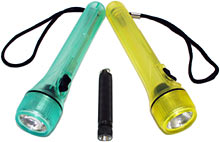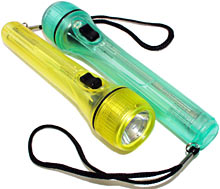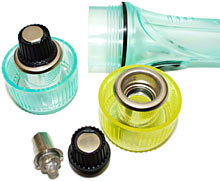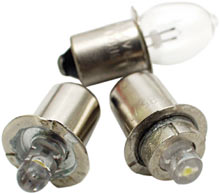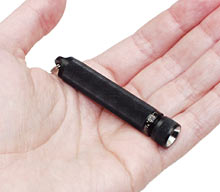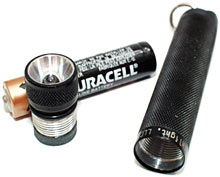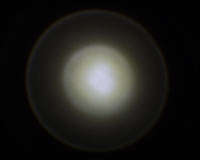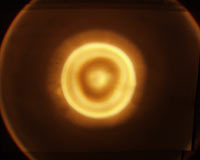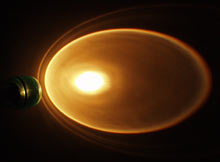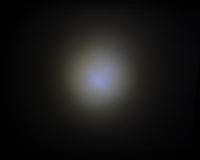
Starlite and Arc-AAA LED flashlights
Review date: 10 August 2001.Last modified 03-Dec-2011.
One problem with using high intensity LEDs for flashlights is that the darn things just want too many batteries.
That's not because they draw a ton of current. White LEDs need about as much power for a given light level as do halogen incandescent globes, and coloured LEDs are more efficient than that.
No - LEDs need too many batteries because they need too many volts.
Your standard small flashlight should run from two 1.5 volt cells - AAs or even AAAs if you want a slim light, C cells if you don't mind a bit more bulk in return for three times the capacity.
If you have to go to three cells, though, a flashlight with a normal end-to-end battery compartment ends up too long for a pocket. You can try running it from weeny little "N" or button cells, or special lithium cells, but the lithiums are crummy value for money, and with anything else your battery life will stink.
It's not terribly difficult to make ordinary incandescent light globes that work from one or two cells. An incandescent globe just contains a resistive metal filament that gets hot when current passes through it, after all. When enough current's flowing, it glows brightly enough to be a useful light source. If you want to make a given filament work on fewer volts, you basically just have to make it shorter.
There are laws-of-physics limitations involved, and making really tiny, really low voltage incandescent globes with reasonable light output is quite challenging. But it can be done, and has.
LEDs aren't like that.
No high intensity LED - the types that spit out a worthwhile amount of light, as opposed to the types that are only useful as indicator lights - will work properly from one 1.5 volt cell.
Red high intensity LEDs are the least voltage-hungry, and even they want at least 1.7 volts to "fire" properly. You can get that - just - from a single lithium AA cell, but an alkaline won't cut it. And the better high intensity reds really want two volts, anyway.
High intensity LEDs with colours further up the spectrum - which appear brighter for a given power consumption, because of the way human vision works - are even worse. You need at least 2.5 volts to run most bright blue and green LEDs, and more for the brightest models. And you'll need 3.6 volts or more for white LEDs, because a white LED is just a super-bright blue LED with a special phosphor coating.
All of the LED lights I've reviewed so far (here, here, here and here, in reverse chronological order) have thus been powered by at least three cells. Three fresh 1.5 volt cells under the load from pretty much any LED light will sag to less than four volts, and tend downwards further as they flatten.
Some of these lights have microprocessor control, one of them even has a voltage regulator, but none of them are made to work from just two cells. And certainly not from only one.
Another problem with these things is that, compared with a supermarket flashlight or even a decent name brand torch like any of the super-popular Mag-Lites, LED flashlights are painfully expensive.
This is partly because LED flashlights aren't made in enormous numbers compared with incandescent lights; economies of scale apply. But it's also because LED lights use a "bulb" that, for recent-model ultra-bright LEDs, costs at least a few US bucks just by itself.
LED flashlights with lots of LEDs in 'em - which is the only way, so far, to get light output that beats that from basic two-cell incandescent flashlights - thus have some serious input costs. The 14-LED Tektite Expedition 1400 I review here has an easy $US50 worth of LEDs in it, at retail prices.
On the plus side, LED lights have practically infinite lamp life. The bulb, she will not burn out. And white LEDs give a marvellously clean white beam - not the yellow you get from normal incandescents, and generally without nasty reflector distortions. And LED lights work better from near-flat batteries than incandescent lights do, which saves money and makes environmentalists feel better.
But they still need a lot of batteries, and they're still expensive.
Given these limitations, I was rather happy to receive some new products from two manufacturers that both solve the too-many-batteries problem. They use a DC-to-DC converter that boosts the voltage from one or two cells to power a single high intensity LED. And one of these manufacturers has even managed to make LED flashlights reasonably cheap.
The two cheerful-coloured lights are the cheap ones. They're Sino Union Technology "Starlites". If you're searching for information about them, you may be confused by the fact that there's another LED light called the "Starlite"; it's a variable-brightness red-LED lamp made specifically for astronomers and other people who want something that'll let them read charts and adjust equipment without hurting their night vision. You can read about it and its relatives on the Rigel Systems page here, but it's got nothing to do with the Sino Union product.
The little black thing in the above picture is the latest model of Arc-AAA light, from Arc Flashlight, LLC.
(Who, I'm afraid, went broke) about three years after I wrote this review.)
The Starlites use two AA cells; the Arc uses a single AAA.
Let's look at the bigger ones first.
Starlites
The candy-coloured translucent bodies of the Starlites are better made than your typical discount-store flashlight, but they've got no amazing features. See-through plastic, conventional slide switch, wrist-strap lanyard. The lamp assembly is the interesting part.
Unscrew the end of the Starlites, and you find a completely normal bulb holder, containing a completely non-normal bulb.
Sino Union's "Night Pearl" lamp is a white LED backed by a DC-to-DC converter. What's particularly nifty about this is that the Night Pearl comes in a standard torch-globe package, so you can use it in any two-cell flashlight that accepts the same bulb form factor. Both of these Starlites use flange fitting globes of the normal 3/8th inch shank type, but there's a screw-fitting version of the Night Pearl as well.
The Night Pearl also comes in two beam width variants. Sino Union sent me one of each.
On the right, the profiled-LED lamp kind of Night Pearl, which works with a reflector to give a narrow beam. It looks very much like the profiled lamps in a couple of the LEDCorp flashlights which I review here.
On the left, the plain unmolested LED kind of Night Pearl, which gives a broader beam. The Starlite that uses this lamp also has a reflector, but it only catches the relatively small amount of light that escapes the sides of the LED. It makes a difference, but not much of a one; many plain-LED lamps don't have a reflector at all.
The incandescent bulb in the background of the above picture is a plain Eveready "2.4 volt" two-cell flashlight globe. I put the voltage in quotation marks, because that's not necessarily what it'll get from two real batteries, as we'll see.
To enhance the beam behaviour, the Starlites have different lamp housing designs.
The Starlite on the left is the model 128L (which can be had in various body colours; this one just happens to be green). Its lamp assembly's got a reflector at the back and a simple lens at the front - not just a flat piece of plastic. It uses the normal-shaped LED.
This gives it a beam with light distribution not unlike that from a normal flashlight - bright in the middle, with circular artefacts as the light dims out around the edges. I'll have a look at this in more detail later on, in the "Output" section.
The yellow Starlite on the right is the model 128R (also available in various body colours). This is the narrow-beam model, which uses the profiled LED lamp. It has a normal flashlight reflector at the back of the lamp housing, and an interesting circular diffuser in the middle. The middle of the bullseye is a tiny lens, and the result is a quite tight beam without any light distribution oddities.
Thanks to the standard packaging of the Sino Union lamps, you can just unscrew the lamp assembly from either Starlite and swap in a normal globe any time you like. Or, of course, you can put a Night Pearl lamp into any flashlight that uses an ordinary flange fitting globe, like any of the C or D cell Mag-Lites.
The two lights Sino Union sent me both use two-cell lamps, whose maximum input voltage is 3.2 volts. But the company also makes a 1.5-volt-maximum lamp for one-cell flashlights.
And now, the weeny little black thing.
The Arc-AAA
The Arc-AAA is not cheap and cheerful. It is small and serious.
Made from sharp-knurled black anodised aluminium and not a whole lot bigger than the single AAA cell that powers it, the Arc-AAA feels rock solid. It does not rattle or squeak. You turn it on and off by turning the end of the light, and the turning action is firm but not stiff. The single LED doesn't protrude from the end of the light; it's at the bottom of a small conical reflector, which is more useful as a LED protector than as a light enhancer. There's no lens on the end of the light; an LED doesn't really need one for protection.
The Arc is also not a big toy. Not counting the removable split-ring that's attached as standard (which allows you to make the Arc part of your keyring, or attach it to a lanyard), it's about 71.5 by 12.7mm (2.8 by 0.5 inches).
There's one product that the Arc-AAA obviously strongly resembles; the Mag-Lite Solitaire.
The Solitaire - nearest the camera, in this comparison picture - is another single-AAA-cell flashlight. But it uses a tiny incandescent globe, with a spare in the tail-cap, as is normal for Mag-Lites. It's almost exactly the same width as the Arc, but it's 81mm long (3.2 inches).
The Solitaire was the state of the art in affordable tiny flashlights for some time. Lots of people have one of these things dangling from their keyring. The only problem is that they don't work terribly well.
A brand new Solitaire with a brand new AAA cell delivers a pretty fair light, for such a tiny thing (and I'll get to the output comparisons in a moment). But, to do that, it has to draw rather a lot of current at the lousy volt-and-a-bit that's all the AAA cell can deliver under serious load. This means that the Solitaire's battery life is not good, and it also means that the tiny contacts inside the flashlight will, if they become even slightly dodgy, result in an annoyingly intermittent light.
Some Solitaires seem to last very well; others flicker a lot and need regular percussive maintenance.
I haven't used the Arc-AAA long enough to be sure that some similar issue won't crop up, but just looking at the parts of the thing, I really doubt it.
UPDATE: It's now more than two years since I wrote this review. I can now say with authority that the Arc-AAA is a frickin' rock. You can't hurt it. Read all about a newer version here.
The back of the Arc Flashlight is one piece; you unscrew the lamp assembly to change the battery.
This is the latest revision of the Arc-AAA - it's version 2.1, an update of the previous "Gen II" version. It's got a silicone greased O-ring in front of the lamp threads to make it more waterproof (it's still only rated to three feet), and apparently some other design improvements that I'm not qualified to comment on, because I haven't seen one of the older models.
There's a rubber pad at the bottom of the lamp assembly, with a hole in the middle to allow the nipple on the end of the AAA cell to make contact. The pad is the only compressible component in the battery bay - there's no spring at either end.
When the Arc isn't turned on, the pad stops the battery from rattling around. When you tighten the end and make contact, the battery is firmly held between the metal contacts, and has even less room to move. There's enough leeway in the threads to allow you to make successful contact with AAAs that have had their end nipple bashed in, and the Arc-AAA should also be OK with slightly shorter rechargeable AAAs.
The Arc lamp power supply has an automatic low power "moon mode", which it switches to when the battery's close to flat. This is a lot dimmer than the standard "sun mode", but is likely to be a great deal better than running out of light altogether in a few minutes, which is what would otherwise happen.
Output
Out with the big piece of paper again.
As with my previous LED light output tests, I set up my camera 40cm (15.75 inches) from the target, an A3 sheet of paper positioned with its long axis horizontal. The top and bottom edges of the sheet are just inside the frame; they're 297mm (11.7 inches) apart. A 1/20th second exposure with my ISO 100 sensitivity digital camera at its maximum wide angle, F2.8 setting, gives a good exposure level to let you see how useful a flashlight is for normal indoor use; if the paper's pretty well lit, then you've got a flashlight that's more than good enough for seeing what's going on in a darkened house.
No single-LED flashlight is going to give you a mighty police searchlight beam, but a decent single-LED model is good enough for many purposes.
Here's the wide-beam Starlite 128L's output at 1/20th. Bright middle, prominent ring. I actually rather like the light pattern from this thing - it puts most of the light in a pleasing medium-sized cone, with a broad dimly lit circle around that for peripheral vision.
With the flashlight close to the target and angled inwards, you can see the rings from the unusual lamp arrangement.
Here's the output from the Starlite 128R at 1/20th second. It's a reasonably tight beam, but beam tightness has to do with the ratio between the size of the light source and the size of the reflector. This isn't a very big reflector, so you get a beam angle about twice that of the LEDCorp Turtlelite I reviewed here. The total output's much the same, though - it's just spread over more area.
Now I took advantage of the standard lamp fitting in the Starlites, and swapped a plain two-cell incandescent globe into the 128L.
In previous tests, I used my camera's automatic white balance, which makes the yellow light from incandescent flashlights look, if not white, then at least more white. This time, I shone one of my bigger white LED flashlights at the paper and locked the white balance to that setting - so you get to see how yellow incandescent light looks, compared with the blue-white from the LEDs.
Pretty darn yellow, huh?
But also quite a bit brighter, and over a wider area. As we'll see in a moment, the incandescent globe drew a lot more power, but it threw a considerably stronger beam, too.
The light distribution overall was much the same as with the LED globe.
On to the Arc.
Not as bright as the Starlite 128L, but very impressive for something this small. I've gone for a couple of night-time walks with these lights now, and I'm perfectly happy with both of them for seeing-where-I'm-going purposes. No broad beam single-LED light is going to be much use if you want to see what's rustling around at the top of a 50 foot tree, but they're perfectly acceptable by small-torch standards.
Especially if your standard for comparison is a Mag-Lite Solitaire.
I put the Arc's fresh AAA cell in my Solitaire, gave it a new bulb, wiggled it about until it was shining at full brightness, and adjusted it to its tightest beam - once again, with the white balance set to match blue-white LED output.
And here's the result.
So what we have here, folks, is a rare event. The Arc-AAA is actually brighter than the incandescent competition. Usually, LED lights win for durability and battery life, but not for brightness. But the Arc is conclusively a better light than the Solitaire.
So what's the battery life like?
Glad you asked.
Power consumption
The Starlite lamps, unsurprisingly, have identical power consumption figures. Given two decently fresh AA alkalines which delivered 3.07 volts between them when unloaded, the Starlite lamps drew about 80 milliamps, and sucked the batteries down to 2.89 volts.
80mA isn't a severe load for AA alkalines, so the Starlite flashlights should deliver excellent battery life. From fancy high-drain alkalines, 24 straight hours at close to full brightness should be perfectly attainable. Even cheapie off-brand cells should do well.
80mA is a lot of current for a single LED to consume, but these flashlights aren't plain just-connect-the-LED-to-the-batteries units; the DC-to-DC converter takes more current at lower voltage and turns it into less current at higher voltage to light the LED.
How much power the LED is actually getting, therefore, I don't know. But for what it's worth, 80mA at 2.9 volts is 0.23 watts. For most of the life of the batteries, these flashlights will be pulling about a fifth of a watt out of them.
All LED flashlights perform better with low batteries than incandescent globes can manage, because although the light output of LEDs falls off with lowered input voltage, the light colour stays the same. Incandescents get redder and redder as they dim, and one watt of red light is a very great deal less visible than one watt of white.
There's a threshold below which an LED will quite suddenly emit very little light indeed, but that's well below the point where incandescent globes are emitting most of their energy as useless infra-red.
The Starlite lamps I got for review, which are made to work from two cells, give some light from only one cell. But not much. Mind you, they only draw about 20mA from 1.5 volts, which means near-flat batteries won't be killed very quickly by the Starlites.
Most people won't care about this, but if you're stuck with no source of light but your flashlight and no batteries but the old ones you've got in it, it matters. The Arc-AAA's "moon mode" is useful for the same reason.
From a fresh AAA cell, the Arc-AAA, coincidentally, also draws 80mA. That dragged down a fresh 1.55 volt AAA to 1.26V, though; 80mA is a fairly heavy load for one of these little cells.
Once again, the DC-to-DC converter stops me from knowing what current the LED is running at, but the lamp assembly's consuming about a tenth of a watt.
What this means is that the manufacturers' claim that the Arc will deliver five hours of "sun mode" light from a normal alkaline AAA cell seems perfectly plausible. After that, you should have about another six hours of "moon mode". If you need full brightness again, you can turn the Arc off and let the battery catch its breath for a little while. The voltage thus recovered will let the flashlight run in "sun mode" again, for a minute or so, or just a few seconds if the battery's really flat.
The tiny Photon Micro-Light is still the best single LED light in the world if you want something really, really small; their new microprocessor-controlled models are especially groovy. But they all run from button cells which have, at most, maybe a seventh of the capacity of a AAA cell. And that's the CR2032 cell that the dimmer Photons use; the brighter ones use a pair of CR2016s, which have more like a twentieth of a AAA's capacity for these loads, if that.
Lithium cells have a monster shelf life, and with the occasional use that a keyring light is likely to get, they can last for years. But if you turn them on continuously, you'll find that Photon's "12 hour" minimum battery life estimate for the brightest double-cell models (the single-cell ones are alleged to last 120 hours...) is a highly optimistic one.
The Photons will give useful light for a pleasingly long time - it's surprising how little light will do for many purposes, for people with OK night vision. But if you're talking "50% or more of full brightness" then I think the Arc-AAA will outlast them by a big margin, even without taking "moon mode" into account.
Even with the Arc's power-eating DC-to-DC converter taken into account, there's something wrong with the laws o' physics if a AAA cell can't beat a couple of buttons.
Going back to old technology, the "2.4 volt" incandescent torch globe does not get 2.4 volts from a pair of AA cells. Its current draw is much too high for that. When I hooked this lamp up to two fresh AA alkalines, they sagged to 1.93 volts between them as they delivered about 620mA.
Even so, that's 1.2 watts; no wonder the thing's bright.
It does not, however, deliver six times the light that you get from the Sino Union LED lamp. Plain torch globes don't have the efficiency of zooty halogen bulbs, and that's what you need to get about the same luminous efficiency as a current model white LED.
The minuscule incandescent globe from the Mag-Lite Solitaire is not kind to a single AAA cell. Despite its relatively miserable light output, it still draws about 200mA, and hauls even a fresh AAA down to about 1.2 volts. That's 0.24 watts, fading down to about a fifth of a watt as the AAA cell ages. Which would explain why the batteries don't last in these little things.
Buying 'em
You may still be able to find Arc flashlights on sale here and there, despite the bankruptcy of the people that made them; the manufacturers' online store charged $US24.95 for all of the visible-light models of AAA Arc - red, green, blue, orange, turquoise, yellow and white. There was an infrared version too, for $US27.95, and an ultraviolet one for $US49.95.
For comparison, a Mag-Lite Solitaire in a nice little box, with a battery and a lanyard, will only cost you about $AU25 here in Australia, which is half the price of the Arc. You can find them for a few bucks less if you shop around. You can get Solitaires for less than $US10 at various places in the States.
The best thing about the Starlites is their price. They are cheap compared with every other LED light I've seen. The worst thing about them is actually finding one.
Sino Union don't yet have a lot of dealers, you see. You can buy the Starlites retail directly from the manufacturer in Hong Kong, but unfortunately, you have to buy in lots of at least six. They've got a US distributor now, though; Sinotone International Limited in San Francisco. Phone (650) 583-8306, fax (650) 583-8326, e-mail sinotone@yahoo.com.
The wide-angle Starlite 128L has a base retail price of $US6.50 per unit, so you're looking at $US39 plus shipping for six; the narrow-beam 128R costs a dollar more per unit. Batteries aren't included, but since these things are easily a third of the price of most single-LED lights, that's forgivable.
Shipping to Australia is only $US2 per light, so the all-told price for Aussies is $US51, or a bit more than a hundred bucks Australian, for six 128Ls - assuming Customs doesn't slug you for 10% GST on the package. That's not blooming bad for six LED flashlights. But only, of course, if you want six LED flashlights.
Sino Union are also happy to hear from wholesalers, for whom they'll quote lower prices for bulk buys.
Overall
If the Starlites cost the same as other single-LED lights, they'd be nothing special. It's nice that they run from two AAs, but that's not a super-amazing feature by itself.
But they're cheap, and they use a normal number of normal batteries, and they've got decent light output too. If only you could buy them more easily.
I'll update this review if I learn of some dealers that stock them. In the meantime, anybody who wants to get one and also get five handy presents for the geeks in their lives (or just get enough of the things that one can live in the garage, one in the car, one in the basement...) can do so without vast expense. Recommended.
I'm just as impressed with the Arc-AAA, but for different reasons. It's not super-cheap, but it's beautifully made and works very well. The Starlites are tough enough for everyday use, but the Arc-AAA is pretty much bombproof.
The little Arc ought to fit easily in anybody's pocket, and it's got sufficient battery life that people who spend a lot of time peering at things in dark places can use it as an everyday work light without also having to carry a pocket full of batteries. When you do need to change the battery, of course, it's not too hard to find another AAA.
If someone told you that the Arc-AAA was made for the use of astronauts, or some military special forces outfit, you'd believe them. It's tiny and it's practical. Recommended. If you can find one.
Arc-AAA kindly provided by
Arc Flashlight, LLC.
(who went
out of business, but are back now)
Starlites kindly provided by Sino Union Technology.
Sino Union products are available in the USA from Sinotone International Limited in San Francisco. Phone (650) 583-8306, fax (650) 583-8326, e-mail sinotone@yahoo.com.
